The Bananas of Upland East Africa - THE BANANA PROJECT ACHIEVEMENTS AS AT MAY 1990 |
Although the overall project could be described as somewhat poorly founded, based as it was on too many preconceptions, it was one of the most successful international Technical Assistance projects in which I have been involved, or even know of.
By the mid-1980's the ancient tradition of growing bananas as a staple food was on its last legs in the area around Bukoba. A local folk-saying was that if a man could be seen eating his food then he was eating matoke but if he was eating behind closed doors then he was eating maize porridge. The evidence of closed doors was all too common.
| The reason was simple - many, if not most, of the banana shambas
looked as in this picture.
The solution offered was in some ways alien, especially the use of pared corms as "seed material", and in other ways mistrusted, notably the use of carbofuran pesticide, as the decline of the crop was firmly believed to be the result of earlier campaigns promoting the insecticide dieldrin. Unsurprisingly, the extension programme got off to a slow start and an initial idea of promoting the "new" ideas by holding expensive meetings, with free meals as an incentive, really got nowhere. |
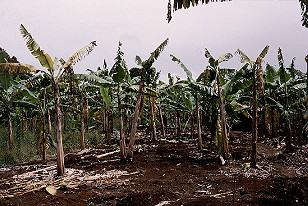 |
| The establishment of the first Project Nursery at Ibura, with a
two-fold objective of having a source of clean seed material and showing
what could be done, probably was the real key to the success. It was
sited on what most local farmers would describe as unsuitable land for
bananas, on a down slope and in thin soil.
A bonus, unrealised by the farmers, however, was that the land not having been used for bananas was free of nematodes. |
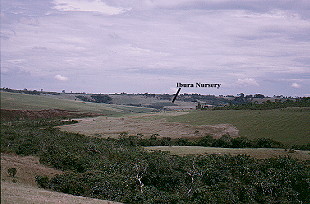 |
| Well dug planting holes, seed material brought in from relatively
healthy areas, and plenty of cow manure, coupled with good husbandry,
proved visibly successful.
It was not only distinguished visitors, such as the Junior Minister of Agriculture, who were able to see what could be achieved. |
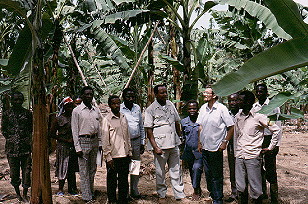 |
| Once the Nursery was starting to produce good seed material, the
next stage of planting "Demonstration" plots got under way.
This one at Kiilima, in Bukoba District, was not long after planting but the good health of the Project stools is clear to see, especially when contrasted with the farmer's own standard planting in the foreground. |
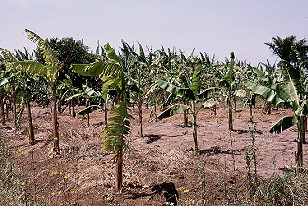 |
| By early 1990, despite no great publicity effort, the simple presence of the Nurseries at Ibura (above), Muleba and Nkwenda (Karagwe), the Extension Demonstration and the Demonstration & Extension Trials, all producing reasonable yields, often in areas where matoke had become something of a rarity (e.g. Kalema, right), showed this to be a Project with which one could be proud to be associated. Farmers came in numbers to seek good, clean planting material and the message began to spread itself. |
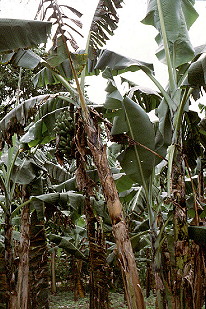 |
It was sad, therefore, that the good work of the project became compromised by the misuse and deviation of resources by certain of the most senior local staff associated with the project extension work at Regional level.
Despite recognition by an independent Evaluation Team and by the authors of a completely separate Regional Development proposal from the UNDP, the EU funding was put into abeyance and ultimately the Project itself simply faded away.
Fortunately, the Project had been able to fund postgraduate training for
Daniel Rukazambuga, my own counterpart, and this led on to his Doctoral
studies in Uganda. My brief summary of his findings is appended
![]() POSTSCRIPT RESEARCH
POSTSCRIPT RESEARCH
| ©2000 - Brian Taylor CBiol FIBiol
FRES 11, Grazingfield, Wilford, Nottingham, NG11 7FN, U.K. Visiting Academic in the Department of Life Science, University of Nottingham Comments to dr.brian.taylor@ntlworld.com |